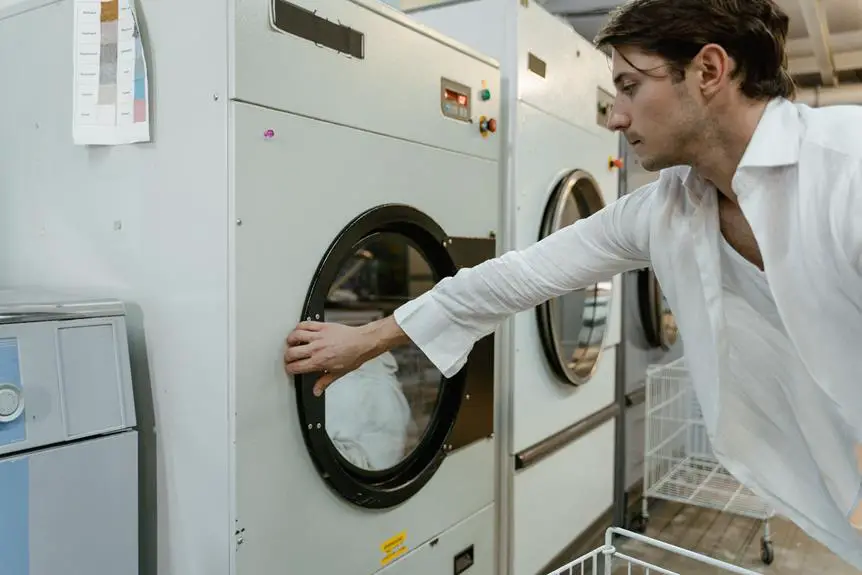If your Samsung dryer isn't spinning, there could be several causes.
It might be due to electrical issues, incorrect control settings, a worn or damaged drive belt, or blockages in the ventilation system.
It could also be caused by mechanical faults like drum and roller problems, a faulty door latch, or problems with the motor and pulley system.
To troubleshoot, check the power supply, ensure the control settings are correct, inspect the drive belt for damage, and make sure the exhaust path is unblocked.
If these steps don't fix the issue, you should contact a professional technician for a more detailed diagnosis and repair.
Troubleshooting Power Issues
To troubleshoot power issues with a Samsung dryer, first ensure the power cord is undamaged and the dryer is plugged into a working outlet. Inspect the power cord for damage like fraying or cuts. Check that the plug is securely connected to the outlet with no loose contacts.
Next, check the home's circuit breaker for a trip. If tripped, reset it and try starting the dryer again. Tripped breakers could suggest an overloaded circuit or a power surge.
If the power supply is stable and the circuit breaker is not tripped, examine the control panel. If the Child Lock feature is active, it may prevent the dryer from starting. Look for a lit Lock icon or try pressing the Child Lock button to deactivate it.
Finally, confirm that the dryer door is fully closed and the exhaust vent is clear of obstructions. Blocked vents can activate safety mechanisms that stop the dryer from operating.
Addressing these issues should resolve most power problems, allowing the dryer to function normally.
Checking Control Settings
When diagnosing a non-spinning Samsung dryer, there are several steps to follow.
First, check for power issues to ensure the dryer is receiving electricity.
Next, verify the control settings on the dryer. A functioning control panel is essential for the dryer to operate correctly.
If the dryer does not spin, look for error codes on the display for troubleshooting.
Another potential issue to consider is the Child Lock feature. This feature, designed to prevent unintended use, can stop the dryer from spinning and make the control panel non-responsive. To check if the Child Lock is activated, look for an icon or label on the control panel indicating its status.
If the Child Lock is on, consult the Samsung dryer manual for instructions on how to deactivate it. Typically, this involves pressing and holding specific buttons.
Additionally, check that the delay start and control lock settings are not preventing the dryer from starting.
Inspecting the Drive Belt
Inspect the drive belt of a Samsung dryer if it stops spinning. The drive belt connects the drum, idler pulley, and motor pulley, allowing the drum to rotate. Check the belt for wear, damage, or looseness after unplugging the dryer for safety. Access to the belt may require removing the top or side panel of the dryer.
Look for fraying, glazing, or thinning on the belt. A loose or detached belt won't turn the drum properly. If the drum rotates without resistance when turned by hand, the belt is likely broken, as a working belt would resist a bit.
If the belt is damaged or broken, replace it with the correct type for your dryer model. Replacing the belt is a simple repair that can make your dryer operational again.
Clearing Clogged Vents
When a Samsung dryer isn't spinning, it could be due to clogged vents, which impede performance. Proper air circulation is crucial for dryer operation, and blockages in the vents can prevent the drum from turning. Lint build-up is a frequent problem that requires proper cleaning.
Always clean the lint trap after each use to avoid clogs. Additionally, check and clean the entire exhaust path, including the outside venting duct, on a regular basis to prevent lint accumulation and ensure good airflow.
Clogged vents may cause the dryer to operate without spinning the drum, resulting in damp clothes or a fire hazard. If the drum moves by hand but not during a cycle, the vents may be blocked. Cleaning the vents might be a DIY task, but for severe or hard-to-reach blockages, it's safer to hire a professional.
Regular vent maintenance improves dryer efficiency, prolongs its life, and reduces the risk of ventilation-related hazards. Regular upkeep is essential for continuous operation and effective drying.
Understanding Door Latch Problems
The door latch is essential for keeping the dryer drum stationary when the door is open and allowing it to spin when closed. A faulty door latch can cause your Samsung dryer not to spin, which could be confused with belt or motor issues. If the door latch is defective, it may not send the signal for the drum to spin, stopping the drying process.
To check for door latch problems, inspect the latch for visible damage or debris. A door that doesn't close firmly may indicate a malfunctioning latch. Manually turning the drum with the door open can help diagnose the issue; if it turns easily, the latch may be at fault.
To prevent damage to the latch, close the dryer door gently rather than slamming it. If the door latch is the reason the dryer drum isn't spinning, you may need to replace it. If you're unsure or the issue continues, contact a professional for an inspection and possible door switch replacement to ensure the dryer operates safely and correctly.
Examining Drum and Rollers
A Samsung dryer's drum may not spin due to issues with the drum or its support components, like the drum rollers. The drum operates with a belt wrapped around it, supported by rollers that allow smooth rotation. Worn-out rollers can impede spinning, causing the dryer to malfunction.
Drum rollers are meant to spin freely, but they can wear out over time, leading to resistance and preventing the drum from turning, even if the belt and motor are fine. It's important to inspect the rollers for wear, such as flat spots or unevenness.
Checking the roller shaft and drum bearings is also crucial to ensure the system can spin effectively. Worn shafts can misalign and increase friction. Replacement of damaged parts is necessary to regain proper dryer function. Replacing all worn rollers at the same time is recommended to avoid future issues and prolong the dryer's life.
Regular maintenance and replacing these parts when needed can prevent inconvenience and costly repairs.
Identifying Motor and Pulley Failures
Motor and pulley failures can cause a Samsung dryer to stop spinning. The motor pulley and drive belt work together to rotate the drum. If they are worn or damaged, the dryer may not spin. Inspecting the belt for wear, such as fraying, can reveal if it has slipped off the pulley.
The tension pulley, or idler pulley, is also important as it maintains the drive belt's tension. If this pulley fails, the belt may slip, stopping the drum from spinning. This is a common issue with dryers and should be addressed quickly.
Drum rollers should also be checked to ensure they're in good condition for the drum to turn smoothly. Worn rollers can increase stress on the motor and belt, leading to possible failures.
If the belt is intact but the drum won't spin, the motor coupling may be broken. This part transfers power from the motor to the drum and will need replacing if defective.
Resolving Electrical Complications
Electrical issues in a Samsung dryer, such as a faulty start switch or a defective main control board, can prevent the drum from spinning even when mechanical parts are functioning. To address these problems, technical knowledge and a systematic approach are necessary.
Ensure the power supply is securely connected. A loose plug may appear as a more complex problem; securing it could solve the issue. If the dryer is plugged in, check the control panel. If the drum light is on but the dryer does not start, the problem could be with the start switch or control board. Refer to the owner's manual for instructions on testing these parts.
The Child Lock feature might be activated, disabling the dryer. Verify whether this feature is on and deactivate it if required. If the control buttons do not respond, reset the dryer by unplugging it for a few minutes, which can help clear electronic glitches.
Check the drive belt for wear through the access panel. If it is worn, replace it to allow the dryer to function correctly.
Also, check your home's electrical panel for a tripped circuit breaker or blown fuse, which can cut power to your dryer.
If these steps do not fix the problem, consider seeking professional help or replacing the dryer. Always prioritize safety and accuracy when troubleshooting. Regularly clean the shaft and surrounding areas to maintain performance.




